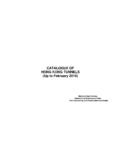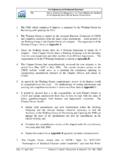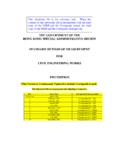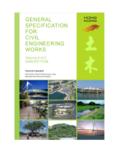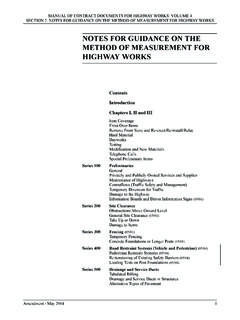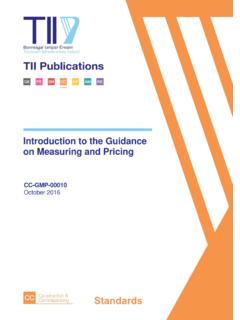Transcription of THE GOVERNMENT OF THE HONG KONG SPECIAL …
1 THE GOVERNMENT OF THE HONG KONG SPECIAL ADMINISTRATIVE REGION STANDARD METHOD OF MEASUREMENT FOR CIVIL ENGINEERING WORKS 1992 EDITION 2 The GOVERNMENT of the Hong Kong SPECIAL Administrative Region First published, April 1992 First reprint, November 1994 Second reprint, December 1995 Third reprint with Corrigendum Nos. 1/93, 1/94, and 1/97 bound with the document, November 1997 Fourth reprint, April 1999 Fifth reprint with Corrigendum Nos. 1/93, 1/94, 1/97, 1/99, 2/99 and 1/2000 bound with the document, December 2000 Sixth reprint with Corrigendum Nos. 1/93, 1/94, 1/97, 1/99, 2/99, 1/2000, 1/2001, 2/2001 and 3/2001 bound with the document, April 2002 Seventh reprint excluding Corrigendum No. 1/2001 Prepared by: Civil Engineering Department, Civil Engineering Building, 101, Princess Margaret Road, Homantin, Kowloon, Hong Kong. This publication is available from: Publications Sales Section, Information Services Department, Room 402, 4/F.
2 , Murray Building, Garden Road, Central, Hong Kong. Future amendments will be published on the website of the Civil Engineering Department at Price in Hong Kong: HK$72 An additional bank charge of HK$50 or US$ is required per cheque made in currencies other than Hong Kong dollars. Cheques, bank drafts or money orders must be made payable to The GOVERNMENT of the Hong Kong SPECIAL Administrative Region. 3 FOREWORD This Method of Measurement lays down the method and criteria for the measurement of civil engineering works undertaken for the Hong Kong GOVERNMENT . It supersedes " GOVERNMENT of Hong Kong, Standard Method of Measurement, 1988 Edition". The Method of Measurement is to be cited as "Standard Method of Measurement for Civil Engineering Works, 1992 Edition (Hong Kong GOVERNMENT )".
3 It is compatible with the "General Conditions of Contract for Civil Engineering Works, 1990 Edition (Hong Kong GOVERNMENT )" and "General Specification for Civil Engineering Works, 1992 Edition (Hong Kong GOVERNMENT )". Where necessary, it should be supplemented by a Particular preamble . The Method of Measurement revises and updates the 1988 edition, mainly to take account of changes that became necessary due to the publication of the 1992 edition of the General Specification. The overall co-ordination for the document, and its final editing and production, were the responsibility of the Standards Unit of the Civil Engineering Department. April 1992 4 CONTENTS PAGE PART I : DEFINITIONS 5 PART II : GENERAL PRINCIPLES 6 PART III : RULES FOR PREPARING BILLS of quantities 7 PART IV : PREAMBLES TO THE BILLS of quantities 9 PART V.
4 UNITS AND METHOD OF MEASUREMENT 13 Section 1 Preliminaries 15 Section 2 Ground Investigation 25 Section 3 Site Clearance 33 Section 4 Fencing 37 Section 5 Drainage and Ducts 41 Section 6 Pipework 57 Section 7 Earthworks 67 Section 8 Roads and Pavings 79 Section 9 Piling Works 93 Section 10 Formwork 107 Section 11 Steel Reinforcement 111 Section 12 Concrete 113 Section 13 In-situ Post-tensioned Prestressing 117 Section 14 Steelwork 119 Section 15 Waterproofing 125 Section 16 Bearings and Movement Joints 127 Section 17 Marine Works 131 Section 18 Tunnelling 139 Section 19 Geotechnical Works 151 Section 20 Railway Works 167 Section 21 Solid Waste Disposal 173 Section 22 Brickwork and Masonry 181 Section 23 Finishings 185 Section 24 Landscape Softworks and Establishment Works 187 Section 25 Testing 191 Section 26 Miscellaneous 199 Section 27 Daywork 205 5 PART I DEFINITIONS 1.
5 In this document entitled "Standard Method of Measurement for Civil Engineering Works", 1992 Edition (Hong Kong GOVERNMENT ), (hereinafter referred to as the "Method of Measurement"), the following words and expressions shall have the meanings hereby respectively assigned to them : (a) "Bills of quantities " means a list of items giving brief identifying descriptions and estimated quantities of the works to be performed; (b) "Daywork" means the method of valuing work on the basis of the time spent by the workmen, the materials used and the plant employed; (c) "Provisional Item" means an item describing work, the requirement for which is uncertain at the time the tender documents are issued and which can only be carried out on instruction of the Engineer; (d) "Preliminary Item" means an item in respect of works and/or general obligations and risks antecedent to or involved in the execution of the Contract and which is set out either in a "Preliminaries" section of the Bills of quantities and relating to the Works as a whole or under a " SPECIAL Preliminaries" sub-heading in any other section of the Bills of quantities ; (e) "Existing ground surface" means the surface of the ground before any work under the Contract has been carried out; (f) "Artificial hard material" means brickwork, concrete, reinforced concrete, masonry, bituminous paving and any other artificial material of a similar nature and which necessitates the use of pneumatic tools or other similar methods for its removal.
6 (g) "Rock" is naturally occurring hard material whose geological nature is to be regarded as such and which necessitates the use of blasting or pneumatic tools or other similar quarrying methods for its removal; (h) "Soft spot" is a volume of earthwork material which is not stated in the Contract to be excavated but which in the opinion of the Engineer has inadequate strength, durability or stability. 2. Words and expressions to which meanings are assigned in the Conditions of Contract have the same meanings in the Method of Measurement. 3. Words and expressions to which meanings are assigned in the Specification and Drawings referred to in the Conditions of Contract have the same meanings in the Method of Measurement. 6 PART II GENERAL PRINCIPLES 1.
7 The Bills of quantities are intended in the first instance to give information upon which tenders can be obtained. When a contract has been entered into, the function of priced Bills of quantities is to provide for the valuation of the work executed. 2. The sub-headings and item descriptions used in the Bills of quantities identify the work covered by the respective items, but the exact nature and extent of the work to be performed is to be ascertained by reference to the Drawings, Specification and Conditions of Contract, as the case may be, in conjunction with the matters listed against the relevant marginal headings "Item coverage" in Part V. The rates to be inserted in the Bills of quantities shall be deemed to be the full inclusive value for the work covered by the respective items and as covering all labour, materials, temporary work, plant, overhead charges and profit, as well as the general liabilities, obligations and risks arising out of the Contract.
8 3. Each item description is to be consistent with and be compounded from one or more of the descriptive features listed in the itemisation groups in the various sections of Part V, as many of these groups or features being used as may be necessary to identify the work required, but not more than one feature from any one group may be represented in any one item description. Where the Method of Measurement does not identify the work required, it shall be amended as appropriate (see Part III, paragraph 10). 4. Unless expressly stated otherwise in the Contract, the Bills of quantities are to contain all those items compounded in accordance with the foregoing paragraph 3 required to comprise the Works (apart from Provisional Sums and Prime Cost Items which may be required).
9 7 PART III RULES FOR PREPARING BILLS of quantities General 1. The Bills of quantities shall comprise the following : - General and Particular Preambles - Bill Number 1 : Preliminaries ) Bill Number 2 : ) :) : ) See below - Bill Number : ) - Bill Number : Daywork ) - Bill Number : Provisional and Prime Cost Sums ) - Grand Summary ) Separate bills shall be prepared for works of different nature, location, date of commencement, time for completion or any other circumstance which may give rise to different considerations of cost. The items in each bill shall be grouped into the appropriate sections of Part V of the Method of Measurement in the order shown therein. Units of 2. The following unit abbreviations shall be used :measurement Unit Abbreviation Millimetre mm Metre m Square millimetre mm 2 Square metre m2 Hectare ha Cubic metre m3 Kilogram kg Tonne t Number nr Hour h Week wk Month mth quantities 3.
10 The quantities shall be computed net from the Drawings, unless directed otherwise by a measurement rule in the Method of Measurement or by the Contract, and no allowance shall be made for bulking, shrinkage or waste. quantities may be rounded up or down where appropriate. Fractional quantities are not generally necessary but, where required, should not be given to more than one place of decimals. Materials 4. Where the Contractor is to be supplied with materials on Site or where he is to supplied to the collect materials from a designated source, it should be so stated in the item Contractor description in the Bills of quantities . 8 Marine work and 5. Any work not covered by the Marine Works Section, such as piling and concrete work affected by work, and which is affected by non-tidal open water, such as reservoirs or rivers, non-tidal open or tidal water, shall be measured separately in accordance with the relevant water or tidal sections of the Method of Measurement and described under a sub-heading as water being affected by non-tidal open water or tidal water.


